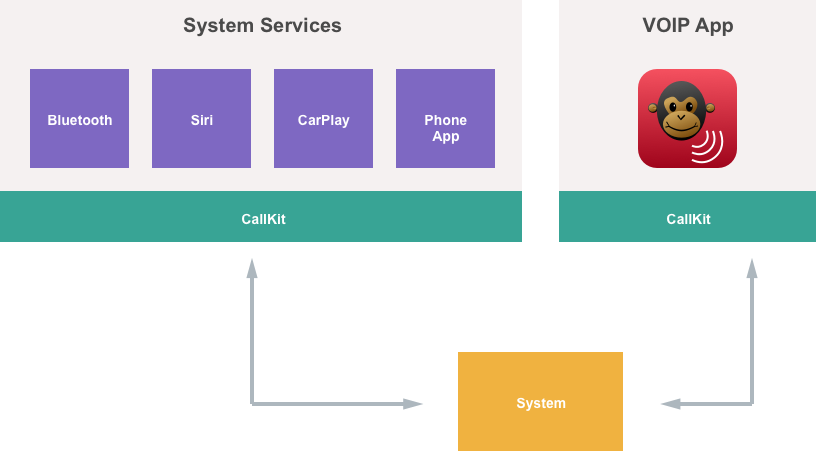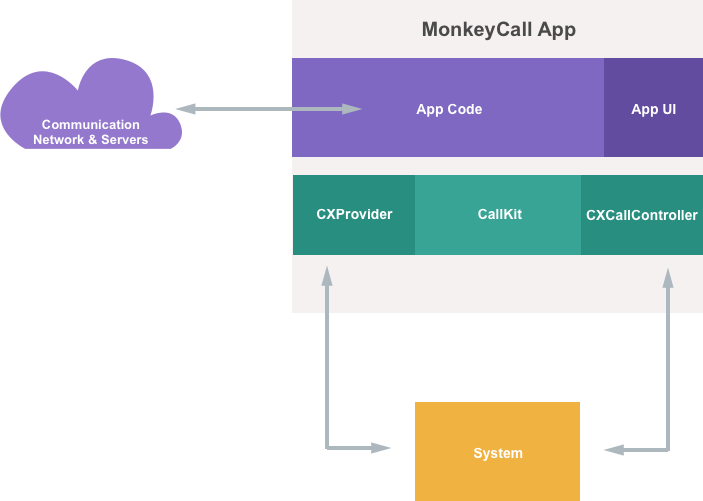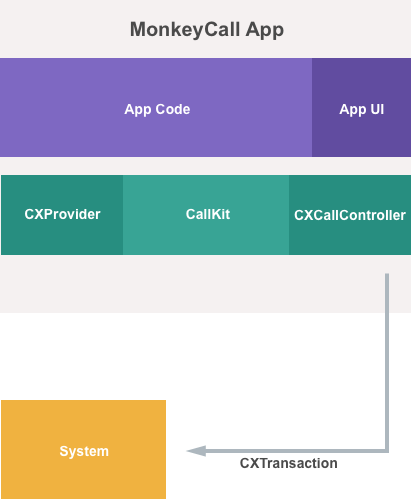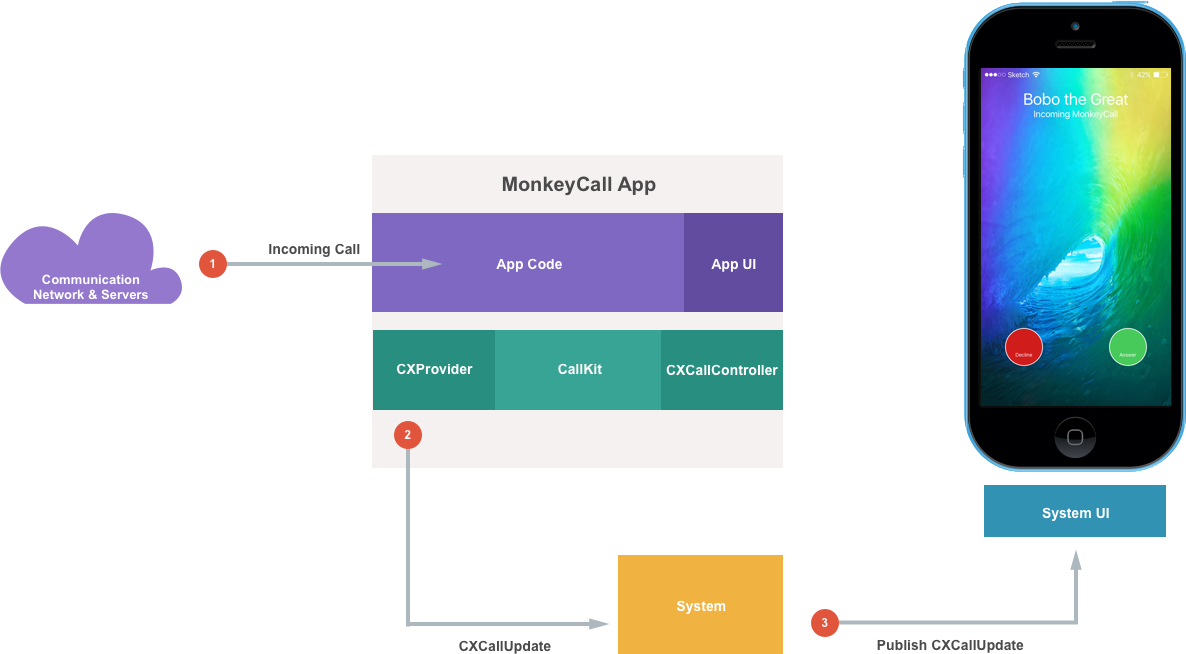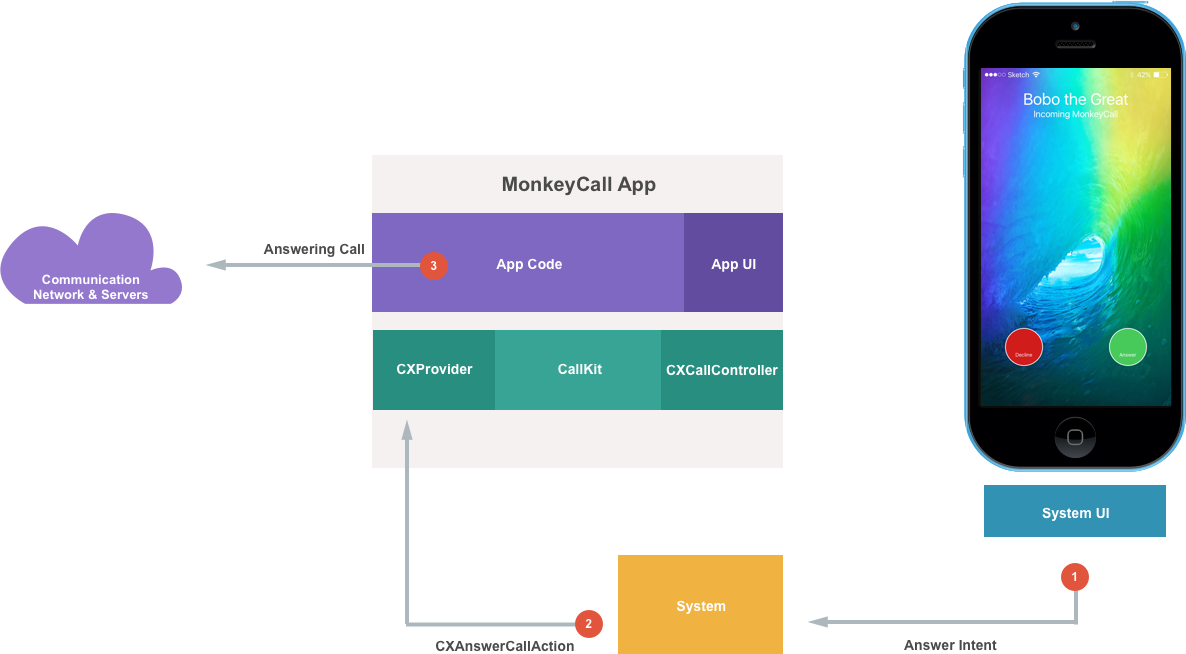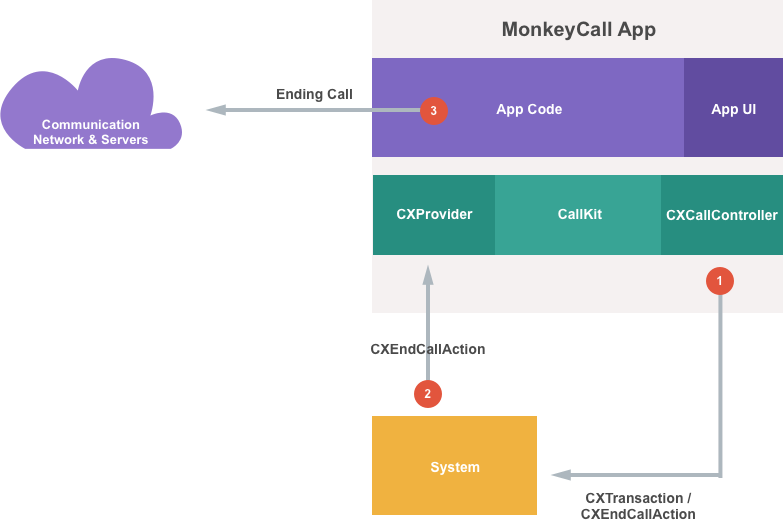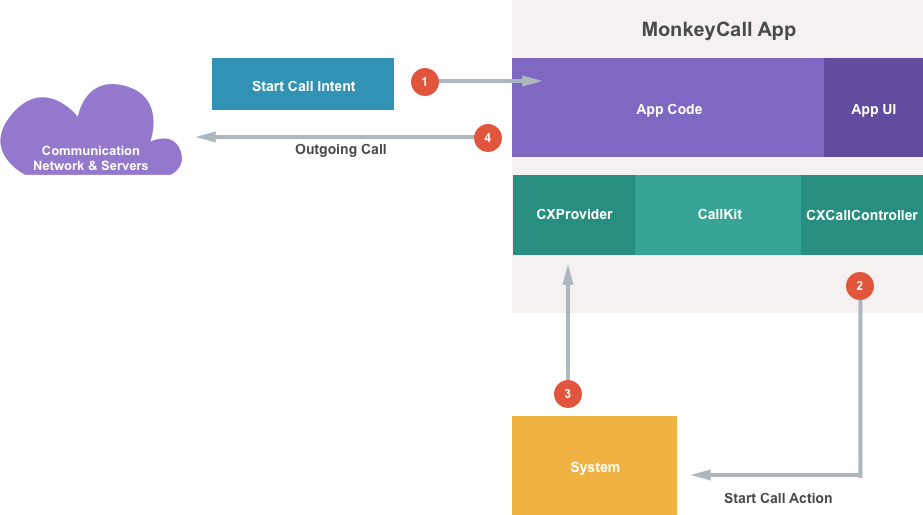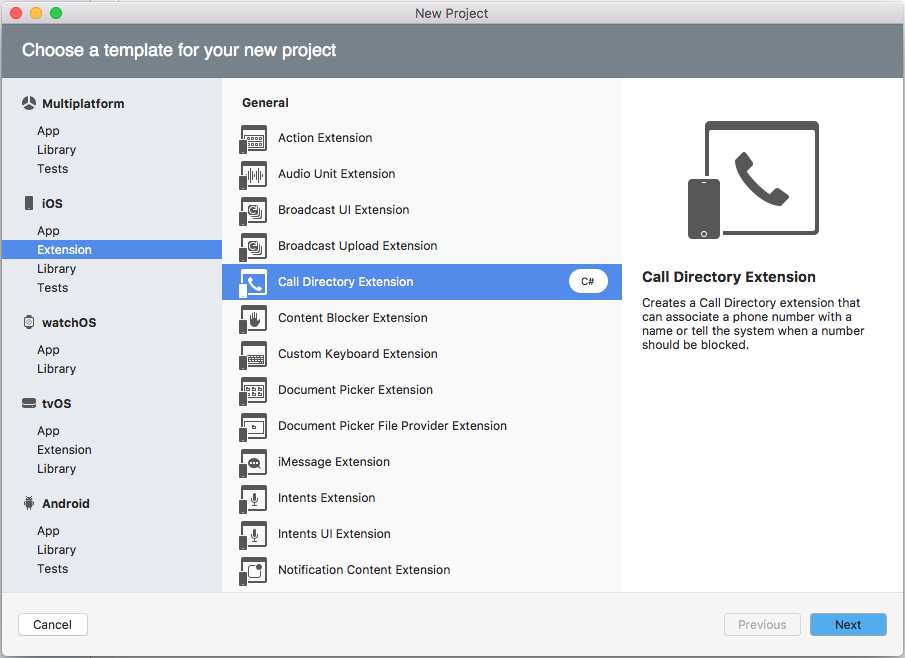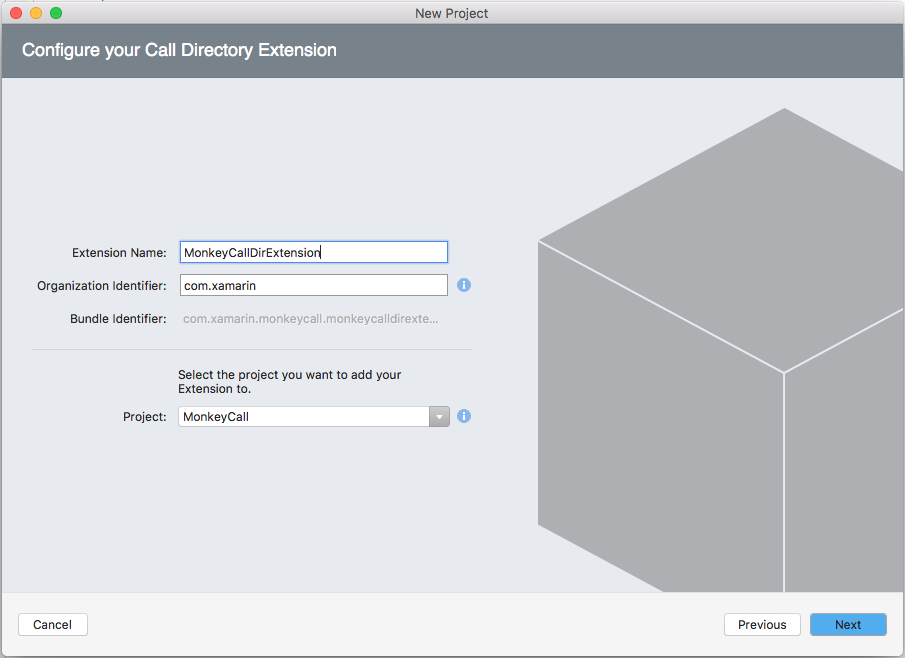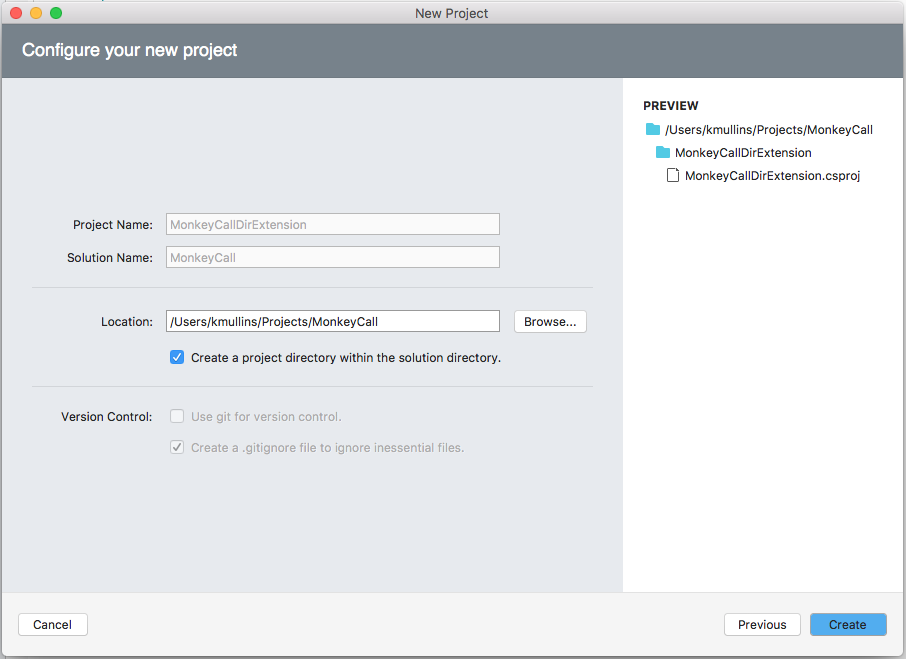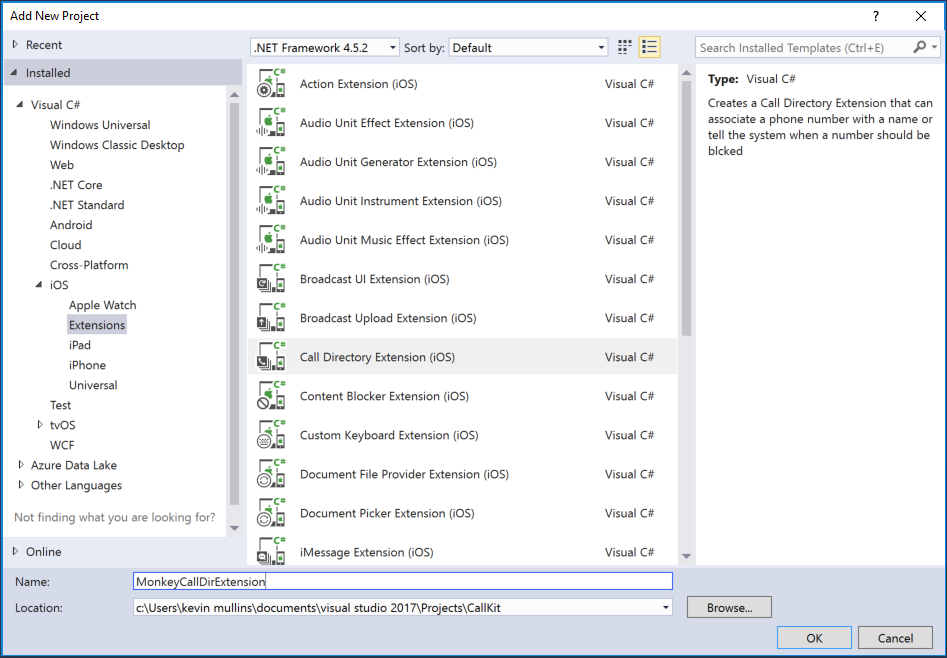CallKit in Xamarin.iOS
The new CallKit API in iOS 10 provides a way for VOIP apps to integrate with the iPhone UI and provide a familiar interface and experience to the end user. With this API users can view and interact with VOIP calls from the iOS device's Lock Screen and manage contacts using the Phone app's Favorites and Recents views.
About CallKit
According to Apple, CallKit is a new framework that will elevate 3rd party Voice Over IP (VOIP) apps to a 1st party experience on iOS 10. The CallKit API allows VOIP apps to integrate with the iPhone UI and provide a familiar interface and experience to the end user. Just like the built-in Phone app, a user can view and interact with VOIP calls from the iOS device's Lock Screen and manage contacts using the Phone app's Favorites and Recents views.
Additionally, the CallKit API provides the ability to create App Extensions that can associate a phone number with a name (Caller ID) or tell the system when a number should be blocked (Call Blocking).
The existing VOIP app experience
Before discussing the new CallKit API and its abilities, take a look at the current user experience with a 3rd party VOIP app in iOS 9 (and lesser) using a fictitious VOIP app called MonkeyCall. MonkeyCall is a simple app that allows the user to send and receive VOIP calls using the existing iOS APIs.
Currently, if the user is receiving an incoming call on MonkeyCall and their iPhone is locked, the notification received on the Lock screen is indistinguishable from any other type of notification (like those from the Messages or Mail apps for example).
If the user wanted to answer the call, they'd have to slide the MonkeyCall notification to open the app and enter their passcode (or user Touch ID) to unlock the phone before they could accept the call and start the conversation.
The experience is equally cumbersome if the phone is unlocked. Again, the incoming MonkeyCall call is displayed as a standard notification banner that slides in from the top of the screen. Since the notification is temporary, it can be easily missed by the user forcing them to either open the Notification Center and find the specific notification to answer then call or find and launch the MonkeyCall app manually.
The CallKit VOIP app experience
By implementing the new CallKit APIs in the MonkeyCall app, the user's experience with an incoming VOIP call can be greatly improved in iOS 10. Take the example of the user receiving a VOIP call when their phone is locked from above. By implementing CallKit, the call will appear on the iPhone's Lock screen, just as it would if the call was being received from the built-in Phone app, with the full-screen, native UI and standard swipe-to-answer functionality.
Again, if the iPhone is unlocked when a MonkeyCall VOIP call is received, the same full-screen, native UI and standard swipe-to-answer and tap-to-decline functionality of the built-in Phone app is presented and MonkeyCall has the option of playing a custom ringtone.
CallKit provides additional functionality to MonkeyCall, allowing its VOIP calls to interact with other types of calls, to appear in the built in Recents and Favorite lists, to use the built-in Do Not Disturb and Block features, start MonkeyCall calls from Siri and offers the ability for users to assign MonkeyCall calls to people in the Contacts app.
The following sections will cover the CallKit architecture, the incoming and outgoing call flows and the CallKit API in detail.
The CallKit architecture
In iOS 10, Apple has adopted CallKit in all of the System Services such that calls made on CarPlay, for example, are known to the System UI via CallKit. In the example given below, since MonkeyCall adopts CallKit, it is known to the System in the same way as these built-in System Services and gets all of the same features:
Take a closer look at the MonkeyCall App from the diagram above. The app contains all of its code to communicate with its own network and contains its own User Interfaces. It links in CallKit to communicate with the system:
There are two main interfaces in CallKit that the app uses:
CXProvider- This allows the MonkeyCall app to inform the system of any out-of-band notifications that might occur.CXCallController- Allows the MonkeyCall app to inform the system of local user actions.
The CXProvider
As stated above, CXProvider allows an app to inform the system of any out-of-band notifications that might occur. These are notification that do not occur due to local user actions, but occur due to external events such as incoming calls.
An app should use the CXProvider for the following:
- Report an incoming call to the System.
- Report an that outgoing call has connected to the System.
- Report the remote user ending the call to the System.
When the app wants to communicate to the system, it uses the CXCallUpdate class and when the System needs to communicate with the app, it uses the CXAction class:
The CXCallController
The CXCallController allows an app to inform the system of local user actions such as the user starting a VOIP call. By implementing a CXCallController the app gets to interplay with other types of calls in the system. For example, if there is already an active telephony call in progress, CXCallController can allow the VOIP app to place that call on hold and start or answer a VOIP call.
An app should use the CXCallController for the following:
- Report when the user has started an outgoing call to the System.
- Report when the user answers an incoming call to the System.
- Report when the user ends a call to the System.
When the app wants to communicate local user actions to the system, it uses the CXTransaction class:
Implementing CallKit
The following sections will show how to implement CallKit in a Xamarin.iOS VOIP app. For the sake of example, this document will be using code from the fictitious MonkeyCall VOIP app. The code presented here represents several supporting classes, the CallKit specific parts will covered in detail in the following sections.
The ActiveCall class
The ActiveCall class is used by the MonkeyCall app to hold all of the information about a VOIP call that is currently active as follows:
using System;
using CoreFoundation;
using Foundation;
namespace MonkeyCall
{
public class ActiveCall
{
#region Private Variables
private bool isConnecting;
private bool isConnected;
private bool isOnhold;
#endregion
#region Computed Properties
public NSUuid UUID { get; set; }
public bool isOutgoing { get; set; }
public string Handle { get; set; }
public DateTime StartedConnectingOn { get; set;}
public DateTime ConnectedOn { get; set;}
public DateTime EndedOn { get; set; }
public bool IsConnecting {
get { return isConnecting; }
set {
isConnecting = value;
if (isConnecting) StartedConnectingOn = DateTime.Now;
RaiseStartingConnectionChanged ();
}
}
public bool IsConnected {
get { return isConnected; }
set {
isConnected = value;
if (isConnected) {
ConnectedOn = DateTime.Now;
} else {
EndedOn = DateTime.Now;
}
RaiseConnectedChanged ();
}
}
public bool IsOnHold {
get { return isOnhold; }
set {
isOnhold = value;
}
}
#endregion
#region Constructors
public ActiveCall ()
{
}
public ActiveCall (NSUuid uuid, string handle, bool outgoing)
{
// Initialize
this.UUID = uuid;
this.Handle = handle;
this.isOutgoing = outgoing;
}
#endregion
#region Public Methods
public void StartCall (ActiveCallbackDelegate completionHandler)
{
// Simulate the call starting successfully
completionHandler (true);
// Simulate making a starting and completing a connection
DispatchQueue.MainQueue.DispatchAfter (new DispatchTime(DispatchTime.Now, 3000), () => {
// Note that the call is starting
IsConnecting = true;
// Simulate pause before connecting
DispatchQueue.MainQueue.DispatchAfter (new DispatchTime (DispatchTime.Now, 1500), () => {
// Note that the call has connected
IsConnecting = false;
IsConnected = true;
});
});
}
public void AnswerCall (ActiveCallbackDelegate completionHandler)
{
// Simulate the call being answered
IsConnected = true;
completionHandler (true);
}
public void EndCall (ActiveCallbackDelegate completionHandler)
{
// Simulate the call ending
IsConnected = false;
completionHandler (true);
}
#endregion
#region Events
public delegate void ActiveCallbackDelegate (bool successful);
public delegate void ActiveCallStateChangedDelegate (ActiveCall call);
public event ActiveCallStateChangedDelegate StartingConnectionChanged;
internal void RaiseStartingConnectionChanged ()
{
if (this.StartingConnectionChanged != null) this.StartingConnectionChanged (this);
}
public event ActiveCallStateChangedDelegate ConnectedChanged;
internal void RaiseConnectedChanged ()
{
if (this.ConnectedChanged != null) this.ConnectedChanged (this);
}
#endregion
}
}
ActiveCall holds several properties that define the state of the call and two events that can be raised when the call state changes. Since this is an example only, there are three methods used to simulated starting, answering and ending a call.
The StartCallRequest class
The StartCallRequest static class, provides a few helper methods that will be used when working with outgoing calls:
using System;
using Foundation;
using Intents;
namespace MonkeyCall
{
public static class StartCallRequest
{
public static string URLScheme {
get { return "monkeycall"; }
}
public static string ActivityType {
get { return INIntentIdentifier.StartAudioCall.GetConstant ().ToString (); }
}
public static string CallHandleFromURL (NSUrl url)
{
// Is this a MonkeyCall handle?
if (url.Scheme == URLScheme) {
// Yes, return host
return url.Host;
} else {
// Not handled
return null;
}
}
public static string CallHandleFromActivity (NSUserActivity activity)
{
// Is this a start call activity?
if (activity.ActivityType == ActivityType) {
// Yes, trap any errors
try {
// Get first contact
var interaction = activity.GetInteraction ();
var startAudioCallIntent = interaction.Intent as INStartAudioCallIntent;
var contact = startAudioCallIntent.Contacts [0];
// Get the person handle
return contact.PersonHandle.Value;
} catch {
// Error, report null
return null;
}
} else {
// Not handled
return null;
}
}
}
}
The CallHandleFromURL and CallHandleFromActivity classes are used in the AppDelegate to get the contact handle of the person being called in an outgoing call. For more information, please see the Handling Outgoing Calls section below.
The ActiveCallManager class
The ActiveCallManager class handles all open calls in the MonkeyCall app.
using System;
using System.Collections.Generic;
using Foundation;
using CallKit;
namespace MonkeyCall
{
public class ActiveCallManager
{
#region Private Variables
private CXCallController CallController = new CXCallController ();
#endregion
#region Computed Properties
public List<ActiveCall> Calls { get; set; }
#endregion
#region Constructors
public ActiveCallManager ()
{
// Initialize
this.Calls = new List<ActiveCall> ();
}
#endregion
#region Private Methods
private void SendTransactionRequest (CXTransaction transaction)
{
// Send request to call controller
CallController.RequestTransaction (transaction, (error) => {
// Was there an error?
if (error == null) {
// No, report success
Console.WriteLine ("Transaction request sent successfully.");
} else {
// Yes, report error
Console.WriteLine ("Error requesting transaction: {0}", error);
}
});
}
#endregion
#region Public Methods
public ActiveCall FindCall (NSUuid uuid)
{
// Scan for requested call
foreach (ActiveCall call in Calls) {
if (call.UUID.Equals(uuid)) return call;
}
// Not found
return null;
}
public void StartCall (string contact)
{
// Build call action
var handle = new CXHandle (CXHandleType.Generic, contact);
var startCallAction = new CXStartCallAction (new NSUuid (), handle);
// Create transaction
var transaction = new CXTransaction (startCallAction);
// Inform system of call request
SendTransactionRequest (transaction);
}
public void EndCall (ActiveCall call)
{
// Build action
var endCallAction = new CXEndCallAction (call.UUID);
// Create transaction
var transaction = new CXTransaction (endCallAction);
// Inform system of call request
SendTransactionRequest (transaction);
}
public void PlaceCallOnHold (ActiveCall call)
{
// Build action
var holdCallAction = new CXSetHeldCallAction (call.UUID, true);
// Create transaction
var transaction = new CXTransaction (holdCallAction);
// Inform system of call request
SendTransactionRequest (transaction);
}
public void RemoveCallFromOnHold (ActiveCall call)
{
// Build action
var holdCallAction = new CXSetHeldCallAction (call.UUID, false);
// Create transaction
var transaction = new CXTransaction (holdCallAction);
// Inform system of call request
SendTransactionRequest (transaction);
}
#endregion
}
}
Again, since this is a simulation only, the ActiveCallManager only maintains a collection of ActiveCall objects and has a routine for finding a given call by its UUID property. It also includes methods to start, end and change the on-hold state of an outgoing call. For more information, please see the Handling Outgoing Calls section below.
The ProviderDelegate class
As discussed above, a CXProvider provides two-way communication between the app and the System for out-of-band notifications. The developer needs to provide a custom CXProviderDelegate and attach it to the CXProvider for the app to handle out-of-band CallKit events. MonkeyCall uses the following CXProviderDelegate:
using System;
using Foundation;
using CallKit;
using UIKit;
namespace MonkeyCall
{
public class ProviderDelegate : CXProviderDelegate
{
#region Computed Properties
public ActiveCallManager CallManager { get; set;}
public CXProviderConfiguration Configuration { get; set; }
public CXProvider Provider { get; set; }
#endregion
#region Constructors
public ProviderDelegate (ActiveCallManager callManager)
{
// Save connection to call manager
CallManager = callManager;
// Define handle types
var handleTypes = new [] { (NSNumber)(int)CXHandleType.PhoneNumber };
// Get Image Template
var templateImage = UIImage.FromFile ("telephone_receiver.png");
// Setup the initial configurations
Configuration = new CXProviderConfiguration ("MonkeyCall") {
MaximumCallsPerCallGroup = 1,
SupportedHandleTypes = new NSSet<NSNumber> (handleTypes),
IconTemplateImageData = templateImage.AsPNG(),
RingtoneSound = "musicloop01.wav"
};
// Create a new provider
Provider = new CXProvider (Configuration);
// Attach this delegate
Provider.SetDelegate (this, null);
}
#endregion
#region Override Methods
public override void DidReset (CXProvider provider)
{
// Remove all calls
CallManager.Calls.Clear ();
}
public override void PerformStartCallAction (CXProvider provider, CXStartCallAction action)
{
// Create new call record
var activeCall = new ActiveCall (action.CallUuid, action.CallHandle.Value, true);
// Monitor state changes
activeCall.StartingConnectionChanged += (call) => {
if (call.isConnecting) {
// Inform system that the call is starting
Provider.ReportConnectingOutgoingCall (call.UUID, call.StartedConnectingOn.ToNSDate());
}
};
activeCall.ConnectedChanged += (call) => {
if (call.isConnected) {
// Inform system that the call has connected
provider.ReportConnectedOutgoingCall (call.UUID, call.ConnectedOn.ToNSDate ());
}
};
// Start call
activeCall.StartCall ((successful) => {
// Was the call able to be started?
if (successful) {
// Yes, inform the system
action.Fulfill ();
// Add call to manager
CallManager.Calls.Add (activeCall);
} else {
// No, inform system
action.Fail ();
}
});
}
public override void PerformAnswerCallAction (CXProvider provider, CXAnswerCallAction action)
{
// Find requested call
var call = CallManager.FindCall (action.CallUuid);
// Found?
if (call == null) {
// No, inform system and exit
action.Fail ();
return;
}
// Attempt to answer call
call.AnswerCall ((successful) => {
// Was the call successfully answered?
if (successful) {
// Yes, inform system
action.Fulfill ();
} else {
// No, inform system
action.Fail ();
}
});
}
public override void PerformEndCallAction (CXProvider provider, CXEndCallAction action)
{
// Find requested call
var call = CallManager.FindCall (action.CallUuid);
// Found?
if (call == null) {
// No, inform system and exit
action.Fail ();
return;
}
// Attempt to answer call
call.EndCall ((successful) => {
// Was the call successfully answered?
if (successful) {
// Remove call from manager's queue
CallManager.Calls.Remove (call);
// Yes, inform system
action.Fulfill ();
} else {
// No, inform system
action.Fail ();
}
});
}
public override void PerformSetHeldCallAction (CXProvider provider, CXSetHeldCallAction action)
{
// Find requested call
var call = CallManager.FindCall (action.CallUuid);
// Found?
if (call == null) {
// No, inform system and exit
action.Fail ();
return;
}
// Update hold status
call.isOnHold = action.OnHold;
// Inform system of success
action.Fulfill ();
}
public override void TimedOutPerformingAction (CXProvider provider, CXAction action)
{
// Inform user that the action has timed out
}
public override void DidActivateAudioSession (CXProvider provider, AVFoundation.AVAudioSession audioSession)
{
// Start the calls audio session here
}
public override void DidDeactivateAudioSession (CXProvider provider, AVFoundation.AVAudioSession audioSession)
{
// End the calls audio session and restart any non-call
// related audio
}
#endregion
#region Public Methods
public void ReportIncomingCall (NSUuid uuid, string handle)
{
// Create update to describe the incoming call and caller
var update = new CXCallUpdate ();
update.RemoteHandle = new CXHandle (CXHandleType.Generic, handle);
// Report incoming call to system
Provider.ReportNewIncomingCall (uuid, update, (error) => {
// Was the call accepted
if (error == null) {
// Yes, report to call manager
CallManager.Calls.Add (new ActiveCall (uuid, handle, false));
} else {
// Report error to user here
Console.WriteLine ("Error: {0}", error);
}
});
}
#endregion
}
}
When an instance of this delegate is created, it's passed the ActiveCallManager that it will use to handle any call activity. Next, it defines the handle types (CXHandleType) that the CXProvider will respond to:
// Define handle types
var handleTypes = new [] { (NSNumber)(int)CXHandleType.PhoneNumber };
And it gets the template image that will be applied to the app's icon when a call is in progress:
// Get Image Template
var templateImage = UIImage.FromFile ("telephone_receiver.png");
These values get bundled into a CXProviderConfiguration that will be used to configure the CXProvider:
// Setup the initial configurations
Configuration = new CXProviderConfiguration ("MonkeyCall") {
MaximumCallsPerCallGroup = 1,
SupportedHandleTypes = new NSSet<NSNumber> (handleTypes),
IconTemplateImageData = templateImage.AsPNG(),
RingtoneSound = "musicloop01.wav"
};
The delegate then creates a new CXProvider with these configurations and attaches itself to it:
// Create a new provider
Provider = new CXProvider (Configuration);
// Attach this delegate
Provider.SetDelegate (this, null);
When using CallKit, the app will no longer create and handle its own audio sessions, instead it will need to configure and use an audio session that the System will create and handle for it.
If this were a real app, the DidActivateAudioSession method would be used to start the call with a pre-configured AVAudioSession that the System provided:
public override void DidActivateAudioSession (CXProvider provider, AVFoundation.AVAudioSession audioSession)
{
// Start the call's audio session here...
}
It would also use the DidDeactivateAudioSession method to finalize and release its connection to the System provided audio session:
public override void DidDeactivateAudioSession (CXProvider provider, AVFoundation.AVAudioSession audioSession)
{
// End the calls audio session and restart any non-call
// releated audio
}
The rest of the code will be covered in detail in the sections that follow.
The AppDelegate class
MonkeyCall uses the AppDelegate to hold instances of the ActiveCallManager and CXProviderDelegate that will be used throughout the app:
using Foundation;
using UIKit;
using Intents;
using System;
namespace MonkeyCall
{
[Register ("AppDelegate")]
public class AppDelegate : UIApplicationDelegate
{
#region Constructors
public override UIWindow Window { get; set; }
public ActiveCallManager CallManager { get; set; }
public ProviderDelegate CallProviderDelegate { get; set; }
#endregion
#region Override Methods
public override bool FinishedLaunching (UIApplication application, NSDictionary launchOptions)
{
// Initialize the call handlers
CallManager = new ActiveCallManager ();
CallProviderDelegate = new ProviderDelegate (CallManager);
return true;
}
public override bool OpenUrl (UIApplication app, NSUrl url, NSDictionary options)
{
// Get handle from url
var handle = StartCallRequest.CallHandleFromURL (url);
// Found?
if (handle == null) {
// No, report to system
Console.WriteLine ("Unable to get call handle from URL: {0}", url);
return false;
} else {
// Yes, start call and inform system
CallManager.StartCall (handle);
return true;
}
}
public override bool ContinueUserActivity (UIApplication application, NSUserActivity userActivity, UIApplicationRestorationHandler completionHandler)
{
var handle = StartCallRequest.CallHandleFromActivity (userActivity);
// Found?
if (handle == null) {
// No, report to system
Console.WriteLine ("Unable to get call handle from User Activity: {0}", userActivity);
return false;
} else {
// Yes, start call and inform system
CallManager.StartCall (handle);
return true;
}
}
...
#endregion
}
}
The OpenUrl and ContinueUserActivity override methods are used when the app is processing an outgoing call. For more information, please see the Handling Outgoing Calls section below.
Handling incoming calls
There are several states and processes that an incoming VOIP call can go through during a typical incoming call workflow such as:
- Informing the user (and the System) that an incoming call exists.
- Receiving notification when the user wants to answer the call and initializing the call with the other user.
- Inform the System and the Communication Network when the user wants to end the current call.
The following sections will take a detailed look at how an app can use CallKit to handle the incoming call workflow, again using the MonkeyCall VOIP app as an example.
Informing user of incoming call
When a remote user has started a VOIP conversation with the local user, the following occurs:
- The app gets a notification from its Communications Network that there is an incoming VOIP call.
- The app uses the
CXProviderto send aCXCallUpdateto the System informing it of the call. - The System publishes the call to the System UI, System Services and any other VOIP apps using CallKit.
For example, in the CXProviderDelegate:
public void ReportIncomingCall (NSUuid uuid, string handle)
{
// Create update to describe the incoming call and caller
var update = new CXCallUpdate ();
update.RemoteHandle = new CXHandle (CXHandleType.Generic, handle);
// Report incoming call to system
Provider.ReportNewIncomingCall (uuid, update, (error) => {
// Was the call accepted
if (error == null) {
// Yes, report to call manager
CallManager.Calls.Add (new ActiveCall (uuid, handle, false));
} else {
// Report error to user here
Console.WriteLine ("Error: {0}", error);
}
});
}
This code creates a new CXCallUpdate instance and attaches a handle to it that will identify the caller. Next, it uses the ReportNewIncomingCall method of the CXProvider class to inform the system of the call. If it is successful, the call is added to the app's collection of active calls, if it isn't, the error needs to be reported to the user.
User answering incoming call
If the user wants to answer the incoming VOIP call, the following occurs:
- The System UI informs the System that the user wants to answer the VOIP call.
- The System sends a
CXAnswerCallActionto the app'sCXProviderinforming it of the Answer Intent. - The app informs its Communication Network that the user is answering the call and the VOIP call proceeds as usual.
For example, in the CXProviderDelegate:
public override void PerformAnswerCallAction (CXProvider provider, CXAnswerCallAction action)
{
// Find requested call
var call = CallManager.FindCall (action.CallUuid);
// Found?
if (call == null) {
// No, inform system and exit
action.Fail ();
return;
}
// Attempt to answer call
call.AnswerCall ((successful) => {
// Was the call successfully answered?
if (successful) {
// Yes, inform system
action.Fulfill ();
} else {
// No, inform system
action.Fail ();
}
});
}
This code first searches for the given call in its list of active calls. If the call can't be found, the system is notified and the method exits. If it is found, the AnswerCall method of the ActiveCall class is called to start the call and the System is information if it succeeds or fails.
User ending incoming call
If the user wishes to terminate the call from within the app's UI, the following occurs:
- The app creates
CXEndCallActionthat gets bundled into aCXTransactionthat is sent to the System to inform it that the call is ending. - The System verifies the End Call Intent and sends the
CXEndCallActionback to the app via theCXProvider. - The app then informs its Communication Network that the call is ending.
For example, in the CXProviderDelegate:
public override void PerformEndCallAction (CXProvider provider, CXEndCallAction action)
{
// Find requested call
var call = CallManager.FindCall (action.CallUuid);
// Found?
if (call == null) {
// No, inform system and exit
action.Fail ();
return;
}
// Attempt to answer call
call.EndCall ((successful) => {
// Was the call successfully answered?
if (successful) {
// Remove call from manager's queue
CallManager.Calls.Remove (call);
// Yes, inform system
action.Fulfill ();
} else {
// No, inform system
action.Fail ();
}
});
}
This code first searches for the given call in its list of active calls. If the call can't be found, the system is notified and the method exits. If it is found, the EndCall method of the ActiveCall class is called to end the call and the System is information if it succeeds or fails. If successful, the call is removed from the collection of active calls.
Managing multiple calls
Most VOIP apps can handle multiple calls at once. For example, if there is currently an active VOIP call and the app gets notification that a there is a new incoming call, the user can pause or hang-up on the first call to answer the second one.
In the situation give above, the System will send a CXTransaction to the app that will include a list of multiple actions (such as the CXEndCallAction and the CXAnswerCallAction). All of these actions will need to be fulfilled individually, so that the System can update the UI appropriately.
Handling outgoing calls
If the user taps an entry from the Recents list (in the Phone app), for example, that is from a call belonging to the app, it will be sent a Start Call Intent by the system:
- The app will create a Start Call Action based on the Start Call Intent that it received from the System.
- The app will use the
CXCallControllerto request the Start Call Action from the system. - If the System accepts the Action, it will be returned to the app via the
XCProviderdelegate. - The app starts the outgoing call with its Communication Network.
For more information on Intents, please see our Intents and Intents UI Extensions documentation.
The outgoing call lifecycle
When working with CallKit and an outgoing call, the app will need to inform the System of the following lifecycle events:
- Starting - Inform the system that an outgoing call is about to start.
- Started - Inform the system that an outgoing call has started.
- Connecting - Inform the system that the outgoing call is connecting.
- Connected - Inform the outgoing call has connected and that both parties can talk now.
For example, the following code will start an outgoing call:
private CXCallController CallController = new CXCallController ();
...
private void SendTransactionRequest (CXTransaction transaction)
{
// Send request to call controller
CallController.RequestTransaction (transaction, (error) => {
// Was there an error?
if (error == null) {
// No, report success
Console.WriteLine ("Transaction request sent successfully.");
} else {
// Yes, report error
Console.WriteLine ("Error requesting transaction: {0}", error);
}
});
}
public void StartCall (string contact)
{
// Build call action
var handle = new CXHandle (CXHandleType.Generic, contact);
var startCallAction = new CXStartCallAction (new NSUuid (), handle);
// Create transaction
var transaction = new CXTransaction (startCallAction);
// Inform system of call request
SendTransactionRequest (transaction);
}
It creates a CXHandle and uses it to configure a CXStartCallAction which is bundled into a CXTransaction that is sent to the System using the RequestTransaction method of the CXCallController class. By calling the RequestTransaction method, the System can place any existing calls on-hold, no matter the source (Phone app, FaceTime, VOIP, etc.), before the new call starts.
The request to start an outgoing VOIP call can come from several different sources, such as Siri, an entry on a Contact card (in the Contacts app) or from the Recents list (in the Phone app). In these situations, the app will be sent a Start Call Intent inside a NSUserActivity and the AppDelegate will need to handle it:
public override bool ContinueUserActivity (UIApplication application, NSUserActivity userActivity, UIApplicationRestorationHandler completionHandler)
{
var handle = StartCallRequest.CallHandleFromActivity (userActivity);
// Found?
if (handle == null) {
// No, report to system
Console.WriteLine ("Unable to get call handle from User Activity: {0}", userActivity);
return false;
} else {
// Yes, start call and inform system
CallManager.StartCall (handle);
return true;
}
}
Here the CallHandleFromActivity method of the helper class StartCallRequest is being used to get the handle to the person being called (see The StartCallRequest Class above).
The PerformStartCallAction method of the ProviderDelegate Class is used to finally start the actual outgoing call and inform the System of its lifecycle:
public override void PerformStartCallAction (CXProvider provider, CXStartCallAction action)
{
// Create new call record
var activeCall = new ActiveCall (action.CallUuid, action.CallHandle.Value, true);
// Monitor state changes
activeCall.StartingConnectionChanged += (call) => {
if (call.IsConnecting) {
// Inform system that the call is starting
Provider.ReportConnectingOutgoingCall (call.UUID, call.StartedConnectingOn.ToNSDate());
}
};
activeCall.ConnectedChanged += (call) => {
if (call.IsConnected) {
// Inform system that the call has connected
Provider.ReportConnectedOutgoingCall (call.UUID, call.ConnectedOn.ToNSDate ());
}
};
// Start call
activeCall.StartCall ((successful) => {
// Was the call able to be started?
if (successful) {
// Yes, inform the system
action.Fulfill ();
// Add call to manager
CallManager.Calls.Add (activeCall);
} else {
// No, inform system
action.Fail ();
}
});
}
It creates an instance of the ActiveCall class (to hold information about the call in progress) and populates with the person being called. The StartingConnectionChanged and ConnectedChanged events are used to monitor and report the outgoing call lifecycle. The call is started and the System informed that the Action was fulfilled.
Ending an outgoing call
When the user has finished with an outgoing call and wishes to end it, the following code can be used:
private CXCallController CallController = new CXCallController ();
...
private void SendTransactionRequest (CXTransaction transaction)
{
// Send request to call controller
CallController.RequestTransaction (transaction, (error) => {
// Was there an error?
if (error == null) {
// No, report success
Console.WriteLine ("Transaction request sent successfully.");
} else {
// Yes, report error
Console.WriteLine ("Error requesting transaction: {0}", error);
}
});
}
public void EndCall (ActiveCall call)
{
// Build action
var endCallAction = new CXEndCallAction (call.UUID);
// Create transaction
var transaction = new CXTransaction (endCallAction);
// Inform system of call request
SendTransactionRequest (transaction);
}
If creates a CXEndCallAction with the UUID of the call to end, bundles it in a CXTransaction that is sent to the System using the RequestTransaction method of the CXCallController class.
Additional CallKit details
This section will cover some additional details that the developer will need to take into consideration when working with CallKit such as:
- Provider Configuration
- Action Errors
- System Restrictions
- VOIP Audio
Provider configuration
The provider configuration allows an iOS 10 VOIP app to customize the user experience (inside the native In-Call UI) when working with CallKit.
An app can make the following types of customizations:
- Display a localized name.
- Enable video call support.
- Customize the buttons on the In-Call UI by presenting its own template image icon. User interaction with custom buttons is sent directly to the app to be processed.
Action errors
iOS 10 VOIP apps using CallKit need to handle Actions failing gracefully and keep the user informed of the Action state at all times.
Take the following example into consideration:
- The app has received a Start Call Action and has begun the process of initializing a new VOIP call with its Communication Network.
- Because of limited or no network communication capability, this connection fails.
- The app must send the Fail message back to the Start Call Action (
Action.Fail()) to inform the System of the failure. - This allows the System to inform the user of the status of the call. For example, to display the Call Failure UI.
Additionally, an iOS 10 VOIP app will need to respond to Timeout Errors that can occur when an expected Action cannot be processed within a given amount of time. Each Action Type provided by CallKit has a maximum Timeout value associated with it. These Timeout values ensure that any CallKit Action requested by the user is handled in a responsive fashion, thus keeping the OS fluid and responsive as well.
There are several methods on the Provider Delegate (CXProviderDelegate) that should be overridden to gracefully handle this Timeout situations as well.
System restrictions
Based on the current state of the iOS device running the iOS 10 VOIP app, certain system restrictions may be enforced.
For example, an incoming VOIP call can be restricted by the System if:
- The person calling is on the user's Blocked Caller List.
- The user's iOS device is in the Do-Not-Disturb mode.
If a VOIP call is restricted by any of these situations, use the following code to handle it:
public class ProviderDelegate : CXProviderDelegate
{
...
public void ReportIncomingCall (NSUuid uuid, string handle)
{
// Create update to describe the incoming call and caller
var update = new CXCallUpdate ();
update.RemoteHandle = new CXHandle (CXHandleType.Generic, handle);
// Report incoming call to system
Provider.ReportNewIncomingCall (uuid, update, (error) => {
// Was the call accepted
if (error == null) {
// Yes, report to call manager
CallManager.Calls.Add (new ActiveCall (uuid, handle, false));
} else {
// Report error to user here
if (error.Code == (int)CXErrorCodeIncomingCallError.CallUuidAlreadyExists) {
// Handle duplicate call ID
} else if (error.Code == (int)CXErrorCodeIncomingCallError.FilteredByBlockList) {
// Handle call from blocked user
} else if (error.Code == (int)CXErrorCodeIncomingCallError.FilteredByDoNotDisturb) {
// Handle call while in do-not-disturb mode
} else {
// Handle unknown error
}
}
});
}
}
VOIP audio
CallKit provides several benefits for handling the audio resources that an iOS 10 VOIP app will require during a live VOIP call. One of the biggest benefits is the app's audio session will have elevated priorities when running in iOS 10. This is the same priority level as the built in Phone and FaceTime apps and this enhanced priority level will prevent other running apps from interrupting the VOIP app's audio session.
Additionally, CallKit has access to other audio routing hints that can enhance the performance and intelligently route VOIP audio to specific output devices during a live call based on user preferences and device states. For example, based on attached devices such as bluetooth headphones, a live CarPlay connection or Accessibility settings.
During the lifecycle of a typical VOIP call using CallKit, the app will need to configure the Audio Stream that CallKit will provide it. Take a look at the following example:
- A Start Call Action is received by the app to answer an incoming call.
- Before this Action is fulfilled by the app, it provides the configuration that is will require for its
AVAudioSession. - The app informs the System that the Action has been fulfilled.
- Before the call connects, CallKit provides a high-priority
AVAudioSessionmatching the configuration that the app requested. The app will be notified via theDidActivateAudioSessionmethod of itsCXProviderDelegate.
Working with call directory extensions
When working with CallKit, Call Directory Extensions provide a way to add blocked call numbers and identify numbers that are specific to a given VOIP app to contacts in the Contact app on the iOS device.
Implementing a Call directory extension
To implement a Call Directory Extension in a Xamarin.iOS app, do the following:
Open the app's solution in Visual Studio for Mac.
Right-click on the Solution Name in the Solution Explorer and select Add > Add New Project.
Select iOS > Extensions > Call Directory Extensions and click the Next button:
Enter a Name for the extension and click the Next button:
Adjust the Project Name and/or Solution Name if required and click the Create button:
This will add a CallDirectoryHandler.cs class to the project that looks like the following:
using System;
using Foundation;
using CallKit;
namespace MonkeyCallDirExtension
{
[Register ("CallDirectoryHandler")]
public class CallDirectoryHandler : CXCallDirectoryProvider, ICXCallDirectoryExtensionContextDelegate
{
#region Constructors
protected CallDirectoryHandler (IntPtr handle) : base (handle)
{
// Note: this .ctor should not contain any initialization logic.
}
#endregion
#region Override Methods
public override void BeginRequest (CXCallDirectoryExtensionContext context)
{
context.Delegate = this;
if (!AddBlockingPhoneNumbers (context)) {
Console.WriteLine ("Unable to add blocking phone numbers");
var error = new NSError (new NSString ("CallDirectoryHandler"), 1, null);
context.CancelRequest (error);
return;
}
if (!AddIdentificationPhoneNumbers (context)) {
Console.WriteLine ("Unable to add identification phone numbers");
var error = new NSError (new NSString ("CallDirectoryHandler"), 2, null);
context.CancelRequest (error);
return;
}
context.CompleteRequest (null);
}
#endregion
#region Private Methods
private bool AddBlockingPhoneNumbers (CXCallDirectoryExtensionContext context)
{
// Retrieve phone numbers to block from data store. For optimal performance and memory usage when there are many phone numbers,
// consider only loading a subset of numbers at a given time and using autorelease pool(s) to release objects allocated during each batch of numbers which are loaded.
//
// Numbers must be provided in numerically ascending order.
long [] phoneNumbers = { 14085555555, 18005555555 };
foreach (var phoneNumber in phoneNumbers)
context.AddBlockingEntry (phoneNumber);
return true;
}
private bool AddIdentificationPhoneNumbers (CXCallDirectoryExtensionContext context)
{
// Retrieve phone numbers to identify and their identification labels from data store. For optimal performance and memory usage when there are many phone numbers,
// consider only loading a subset of numbers at a given time and using autorelease pool(s) to release objects allocated during each batch of numbers which are loaded.
//
// Numbers must be provided in numerically ascending order.
long [] phoneNumbers = { 18775555555, 18885555555 };
string [] labels = { "Telemarketer", "Local business" };
for (var i = 0; i < phoneNumbers.Length; i++) {
long phoneNumber = phoneNumbers [i];
string label = labels [i];
context.AddIdentificationEntry (phoneNumber, label);
}
return true;
}
#endregion
#region Public Methods
public void RequestFailed (CXCallDirectoryExtensionContext extensionContext, NSError error)
{
// An error occurred while adding blocking or identification entries, check the NSError for details.
// For Call Directory error codes, see the CXErrorCodeCallDirectoryManagerError enum.
//
// This may be used to store the error details in a location accessible by the extension's containing app, so that the
// app may be notified about errors which occurred while loading data even if the request to load data was initiated by
// the user in Settings instead of via the app itself.
}
#endregion
}
}
The BeginRequest method in the Call Directory Handler will need to be modified to provide the required functionality. In the case of the sample above, it attempts to set the list of blocked and available numbers in the VOIP app's contacts database. If either requests fails for any reason, create an NSError to describe the failure and pass it the CancelRequest method of the CXCallDirectoryExtensionContext class.
To set the blocked numbers use the AddBlockingEntry method of the CXCallDirectoryExtensionContext class. The numbers provided to the method must be in numerically ascending order. For optimal performance and memory usage when there are many phone numbers, consider only loading a subset of numbers at a given time and using autorelease pool(s) to release objects allocated during each batch of numbers which are loaded.
To inform to Contact app of the contact numbers known to the VOIP app, use the AddIdentificationEntry method of the CXCallDirectoryExtensionContext class and provide both the number and an identifying label. Again, the numbers provided to the method must be in numerically ascending order. For optimal performance and memory usage when there are many phone numbers, consider only loading a subset of numbers at a given time and using autorelease pool(s) to release objects allocated during each batch of numbers which are loaded.
Summary
This article has covered the new CallKit API that Apple released in iOS 10 and how to implement it in Xamarin.iOS VOIP apps. It has shown how CallKit allows an app to integrate into the iOS System, how it provides feature parity with built-in apps (such as Phone) and how it increases an app's visibility throughout iOS in locations such as the Lock and Home Screens, via Siri interactions and via the Contacts apps.
